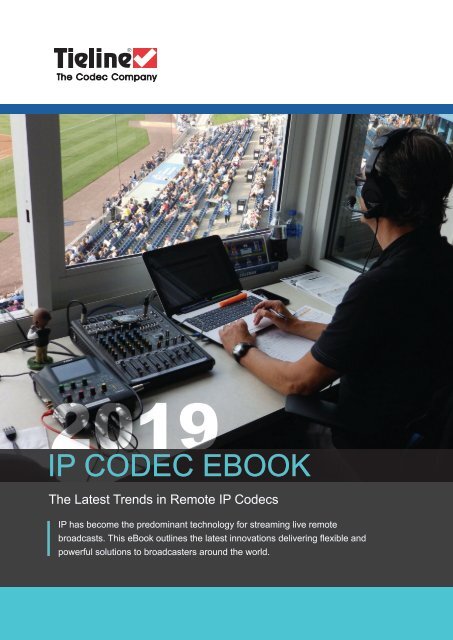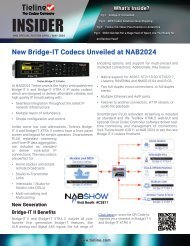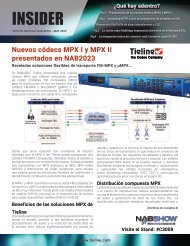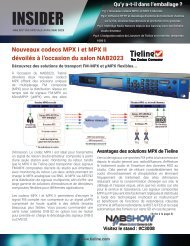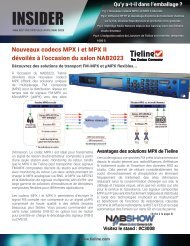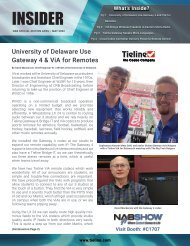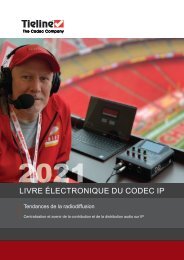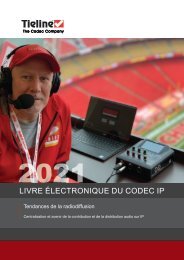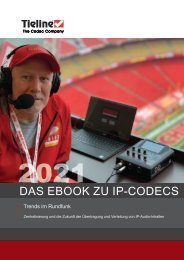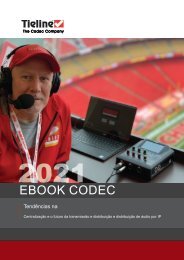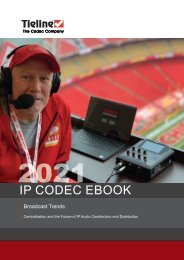(English) 2019 eBook
The Latest Trends in Remote IP Codecs - IP has become the predominant technology for streaming live remote broadcasts. This eBook outlines the latest innovations delivering flexible and powerful solutions to broadcasters around the world.
The Latest Trends in Remote IP Codecs - IP has become the predominant technology for streaming live remote broadcasts. This eBook outlines the latest innovations delivering flexible and powerful solutions to broadcasters around the world.
- No tags were found...
Create successful ePaper yourself
Turn your PDF publications into a flip-book with our unique Google optimized e-Paper software.
<strong>2019</strong><br />
IP CODEC EBOOK<br />
The Latest Trends in Remote IP Codecs<br />
IP has become the predominant technology for streaming live remote<br />
broadcasts. This <strong>eBook</strong> outlines the latest innovations delivering flexible and<br />
powerful solutions to broadcasters around the world.
INTRODUCING<br />
The Remote season <strong>2019</strong> <strong>eBook</strong>...<br />
We outline how you can now remotely control<br />
all your codecs and smartphone app users with<br />
Tieline’s Cloud Codec Controller, and show you<br />
how you can try it for free.<br />
There’s a Report-IT and Merlin PLUS story from<br />
Ben Marshall, Program Director from WMOA<br />
WJAW, who outlines their network’s strategy for<br />
covering at least one hundred and twenty-five<br />
regular season sports broadcasts, with more than<br />
a dozen different schools at the High School and<br />
College level.<br />
As we head into the remote season for <strong>2019</strong>, this<br />
<strong>eBook</strong> explores ‘The Latest Trends in Remote IP<br />
Codecs.‘<br />
At Tieline we’ve been busy creating new solutions<br />
for live streaming over IP. We have developed a<br />
new Dual Active SIM LTE Module supporting two<br />
SIM cards, plus a new software release offers<br />
the ability to configure three SmartStream PLUS<br />
redundant IP streams and a primary IP audio<br />
stream – delivering even more robust and rocksolid<br />
IP connections.<br />
Inside this <strong>eBook</strong> Charlie Gawley will provide an<br />
update on the latest news from broadcast circles in<br />
Europe, with some revealing news about the latest<br />
technology trends.<br />
We go head-to-head with Tieline’s Jacob Daniluck<br />
as he outlines some home truths about broadcasting<br />
over SIP and offers some tips to get you connected<br />
as easy as possible.<br />
We talk turkey when it comes to setting up mixminus<br />
feeds for remotes, including a strategy for<br />
configuring multiple simultaneous mix-minus feeds.<br />
GRAB A CUPPA, SIT BACK AND READ ON…<br />
IP technologies are evolving quickly and sometimes<br />
it’s hard to keep up with all the innovations taking<br />
place. So sit back, grab a coffee and read all about<br />
the latest in IP codec tech news that can take your<br />
remotes to the next level.<br />
William McLean<br />
Chief Executive Officer
THE REMOTE SEASON <strong>2019</strong> EBOOK<br />
CONTENTS<br />
INTRODUCING THE REMOTE SEASON <strong>2019</strong> EBOOK<br />
3<br />
NEW TECHNOLOGIES TO ACHIEVE GREAT REMOTE<br />
BROADCASTS…<br />
4<br />
BROADCAST TRENDS IN EUROPE…<br />
6<br />
REMOTE CONTROL OF YOUR CODECS – ANYWHERE,<br />
ANYTIME…<br />
REPORT-IT AND MERLIN PLUS DELIVER FOR WMOA AND<br />
WKAW SPORTS AND NEWS BROADCASTING<br />
8<br />
11<br />
TO SIP OR NOT TO SIP, THAT IS THE QUESTION…<br />
TECH TIP: SETTING UP IFB MIX MINUS FOR SPORTS<br />
REMOTES<br />
13<br />
16<br />
Tieline: The Codec Company<br />
3
TECHNOLOGIES<br />
New<br />
to achieve great remote broadcasts<br />
Picture this. You’re heading out to do a remote broadcast next week at a large public<br />
event and wondering about the options<br />
available onsite to get audio back to the studio<br />
over IP, plus:<br />
»»<br />
It’s the first time you will have been to<br />
the location and there’s no time to test<br />
connections back to the studio beforehand.<br />
»»<br />
Tens of thousands of people will attend the<br />
event – all using cell phones competing for<br />
cellular bandwidth.<br />
»»<br />
This event is too important to fail!<br />
Planning for any Eventuality…<br />
We’ve all been there at one time or another and being well prepared and flexible is<br />
crucial to successful remote broadcasts.<br />
Flexibility = More Options<br />
So what sort of flexible options are available with remotes in mind? From an IP<br />
connectivity perspective this means using a variety of IP interfaces to reduce the risk<br />
of lost packets. Sharing high-demand cellular networks with thousands of other users<br />
can lead to loss of audio if you are not well-prepared and using packet loss mitigation<br />
strategies.<br />
The Latest Strategies…<br />
Packet loss can occur when thousands of people are trying to access scarce data<br />
resources, however there are various techniques that can make IP streaming as reliable<br />
as circuit switched connections in the past.<br />
»»<br />
Order data plans with cellular data priority where available: Telcos can often supply<br />
access to cellular data plans with QoS, which provide more reliable connectivity in<br />
heavily congested environments like sports stadiums and major events.<br />
»»<br />
Employ multiple redundant IP streams over multiple networks, which greatly<br />
increases the reliability of streaming over IP.<br />
»»<br />
Bond multiple data connections to aggregate data and achieve higher bitrate<br />
connections.<br />
4 www.tieline.com
New Technologies<br />
to achieve great remote broadcasts<br />
Lossless Connections Using Redundant Streaming<br />
Lossless connections are achievable over IP using SmartStream PLUS redundant<br />
streaming. Using this technology packets are assembled on a first packet arrived basis<br />
from any of multiple redundant IP streams, as shown in the following image.<br />
Codecs like the Tieline ViA deliver more IP interface options than other remote codecs,<br />
plus the ability to stream over 4 different interfaces simultaneously. This means you have<br />
more ways to mitigate loss over inherently lossy IP networks like the internet.<br />
IP Interface Options for Remotes<br />
Having the flexibility to connect over multiple IP networks delivers reliability through<br />
redundancy. The Tieline ViA has up to 7 IP interface options, which means you have<br />
more broadcast options available to you when arriving at a remote site.<br />
These options include:<br />
»»<br />
Internal Dual Active SIM LTE Module: supports using 2<br />
SIM cards for Telco diversity.<br />
»»<br />
Built-in Wi-Fi (no USB modem required) supporting<br />
connections to cellular hotspots.<br />
»»<br />
Connect two USB modems/air cards.<br />
»»<br />
Connect two Ethernet connections.<br />
This delivers the type of flexibility required in today’s world, to<br />
enable connections over any available option when at remote<br />
broadcast sites.<br />
Tieline: The Codec Company<br />
5
BROADCAST TRENDS<br />
IN EUROPE<br />
Tieline Insider asks Charlie<br />
Gawley, Tieline’s VP Sales<br />
APAC/EMEA, about the latest<br />
technology trends among<br />
European broadcasters.<br />
Insider:<br />
Charlie you visit a lot of European countries and see a lot of broadcast installations, what<br />
are the key trends you have noticed over the last year or so?<br />
Charlie:<br />
During the last 12 months I have noticed a shift throughout Europe to predominantly<br />
IP broadcasting. This has been evident for audio distribution applications, and remote<br />
outside broadcasts, where reliance on ISDN/E1 circuit switched lines continues to drop<br />
throughout the continent.<br />
Insider:<br />
From the perspective of remote broadcasting, how are broadcasters transitioning into<br />
new technologies?<br />
Charlie:<br />
Most broadcasters are relatively comfortable with IP for live streaming of broadcast<br />
content, however they have become more demanding about redundancy strategies over<br />
IP networks. Infrastructure does vary from country-to-country, but generally wired and/or<br />
wireless IP is able to reliably broadcast from just about anywhere these days.<br />
Insider:<br />
What sort of redundancy strategies are in play?<br />
6 www.tieline.com
BROADCAST TRENDS IN EUROPE<br />
interview with Charlie Gawley<br />
Charlie:<br />
Even though broadband infrastructure is improving all the time, no two networks are the<br />
same. Tieline has employed SmartStream PLUS redundant streaming for many years<br />
now and this is a well-established IP redundancy model in the industry. However, I have<br />
found several European broadcasters requesting more redundancy to employ more<br />
sophisticated and layered approaches to IP backup. That’s why we have developed<br />
new firmware with support for up to 3 redundant IP streams, plus a primary stream, so<br />
theoretically you can send IP audio over 4 separate networks back to the studio.<br />
Insider:<br />
What about remote control, is this important in Europe?<br />
Charlie:<br />
Yes remote control is very important - and I might add it’s by necessity. It’s very evident that<br />
broadcasters are covering more sport generally. Therefore, I am increasingly being asked<br />
about how Tieline can provide solutions which can be given to announcers and taken to<br />
a sports event, festival or wherever, and controlled back at the studio, because there are<br />
not enough technical personnel to go to every event. We have this covered nicely with the<br />
recently released Cloud Codec Controller, which allows engineers to not only remotely<br />
control their IP codecs, but also users of Tieline’s Report-IT Enterprise smartphone app.<br />
Insider:<br />
What about IP bonding, is this talked about much?<br />
Charlie:<br />
Absolutely, some broadcasters employ both SmartStream PLUS redundant IP streaming<br />
and IP bonding simultaneously. Again, broadcasters are moving away from external<br />
boxes that perform bonding and want solutions in a single box, like with Fuse-IP bonding<br />
in the Tieline ViA, which can bond of any of up to 7 available IP interfaces. There are two<br />
reasons for this, one is that bonding-only solutions can be expensive, and secondly, if<br />
everything is handled in the one box then it is simpler to hand to an announcer and say,<br />
‘off you go and broadcast’. There are fewer potential points of failure too.<br />
Insider:<br />
Are any other redundancy strategies employed by engineers?<br />
Charlie:<br />
Yes Forward Error Correction is used extensively, and error correction strategies are<br />
inherent in Tieline IP codecs, so along with redundant streaming and IP bonding, there<br />
are many options to get rock solid audio back to the studio.<br />
Insider:<br />
Thanks Charlie.<br />
Tieline: The Codec Company<br />
7
FEATURE PRODUCT<br />
REMOTE CONTROL OF YOUR CODECS – ANYWHERE, ANYTIME…<br />
HOW CAN I REMOTELY CONTROL CODECS WHEN NON-TECHNICAL PEOPLE<br />
ARE AT THE REMOTE SITE?<br />
One of the most common requests we get at Tieline is “how can I configure and control<br />
a codec when I can’t be at the remote site?” Well, with the Cloud Codec Controller full<br />
remote control of a codec is at your fingertips.<br />
How is this possible? Well Tieline’s Cloud Codec Controller delivers a simple user<br />
interface to configure, connect and manage your entire network of Tieline codecs and all<br />
Report-IT Enterprise users from a single PC located anywhere in the world.<br />
It doesn’t matter whether the device is connected via a LAN or cellular networks, the<br />
Cloud Codec Controller integrates with the latest cloud computing technologies to deliver<br />
secure real-time monitoring and remote control of all Merlin, Genie, ViA and Bridge-IT<br />
codecs, as well as smartphones using Report-IT Enterprise from a single PC located<br />
anywhere in the world.<br />
8 www.tieline.com
CLOUD CODEC CONTROLLER<br />
Remote Control of your Codecs – ANYWHERE, ANYTIME…<br />
SO CAN I REALLY CONTROL REPORT-IT APP USERS REMOTELY?<br />
One of the most amazing things about the Cloud Codec Controller is the ability to<br />
control Report-IT Enterprise app users when the app is launched on a smartphone. This<br />
delivers incredible control and means an engineer can:<br />
»»<br />
View when a user goes online and is ready to connect.<br />
»»<br />
Connect and disconnect individual Report-IT<br />
Enterprise users after they launch the app.<br />
»»<br />
Start and stop recordings, monitor and adjust input<br />
and record levels, lock and unlock controls and<br />
observe link quality.<br />
Tieline: The Codec Company<br />
9
CLOUD CODEC CONTROLLER<br />
Remote Control of your Codecs – ANYWHERE, ANYTIME…<br />
HOW DOES IT WORK?<br />
It’s very simple. An announcer only needs to connect a remote codec to the internet<br />
or launch the Report-IT Enterprise app on their smartphone, and it will be discovered<br />
automatically by the Cloud Codec Controller in a snap! All configuration and dialing can be<br />
configured by an engineer at the studio, or wherever they are in the world.<br />
WATCH THE SHORT VIDEO<br />
Learn more about the powerful remote-control features delivered by the Cloud Codec<br />
Controller.<br />
TRY IT FOR FREE…<br />
Visit www.tieline.com/register and fill out the form to try it for free and learn why other<br />
engineers are raving about the powerful remote control tools provided by Tieline’s Cloud<br />
Codec Controller.<br />
“Tieline ViA is our go-to solution for live remotes,<br />
and our staff love it. The ViA truly is a studio in a<br />
box.”<br />
Henrik Poulsen, Technical Manager for<br />
NORDJYSKE Media<br />
10 www.tieline.com
REPORT-IT & MERLIN PLUS DELIVER<br />
WMOA & WKAW<br />
SPORTS AND NEWS BROADCASTING<br />
By Ben Marshall, WMOA WJAW<br />
Program Director<br />
At WMOA / WJAW radio in Marietta,<br />
Ohio it would be an understatement to<br />
say that local sports are a big deal, and<br />
now with the Merlin PLUS, we’ve taken<br />
our Game to the next level.<br />
Every year we plan for at least one<br />
hundred and twenty-five regular season<br />
sports broadcasts, with more than a<br />
dozen different schools and programs<br />
at the High School and College level playing a variety of sports, including football,<br />
basketball, and baseball. At the very start of <strong>2019</strong>, we began our trial period with the<br />
Merlin PLUS and while there were hiccups with the initial setup, and some growing<br />
pains for our broadcasters getting familiar with the new equipment using IP, it very<br />
quickly became apparent that the Merlin PLUS is the real deal. It must also be said that<br />
everyone we dealt with at Tieline was great. Some of the initial problems we had setting<br />
up our Merlin was just because of the holiday season, with the staff at both our offices<br />
and Tieline taking time off to celebrate. Tieline graciously extended our trial period<br />
through January and they made the whole trial process very smooth.<br />
During our initial broadcast with the Merlin PLUS we could tell instantly that the quality<br />
was great. It was much improved from using cell phone or landlines, and our listeners<br />
noticed right away as well. Putting audio recorded from a basketball game that we<br />
had done on our conventional system next to the Merlin PLUS audio, it was almost<br />
embarrassing the difference in quality - but it made for an easy choice, we NEED this<br />
technology.<br />
I had arranged my demo setup through John Lackness at Broadcast Depot, whom I had<br />
met in Orlando at the 2018 Radio Show, so I was glad that coincidentally enough he<br />
could give me a great deal on the Tieline equipment.<br />
We ordered the Merlin PLUS and the Report-IT app, which we also used during our<br />
Tieline: The Codec Company<br />
11
REPORT-IT & MERLIN PLUS DELIVER<br />
for WMOA & WKAW Sports and News Broadcasting<br />
trial period. The app itself, again very easy to use, is just a simple download from your<br />
app store. One main draw of the Merlin PLUS for us was the ability to have six different<br />
connections (broadcast) going at one time. At the time of writing we have had three<br />
connections broadcasting simultaneously and no discernible drop in connection or<br />
quality.<br />
While the quality of our remotes and sports broadcasts have immediately gone through<br />
the roof, we know that we have just scratched the surface of everything the Merlin PLUS<br />
is capable of. In the future we fully anticipate utilizing the Merlin PLUS to receive live or<br />
pre-recorded interviews from sports events. In addition, the WMOA News team have the<br />
Report-IT app on their phone. If they should happen on an accident downtown all they<br />
have to do is open the app on their phone, and they can be live on the air in minutes<br />
broadcasting with studio quality, even if they don’t have the other broadcast equipment.<br />
The conclusion is simple. The Merlin PLUS drastically and immediately improved our<br />
radio stations. It has made our other forms of remote broadcasting, including our Marti<br />
System, obsolete. I mentioned in the first paragraph about one hundred twenty-five<br />
sports broadcasts, that is just our regular season schedule, and doesn’t include any<br />
type of post season. Not to mention any live broadcast our on-air talent may do, we’re<br />
looking at well over 200 broadcasts a year, and with the Merlin PLUS, every one of them<br />
will be studio quality.<br />
Did You Know…<br />
Did you know that Tieline writes all software and designs and manufactures all audio codecs in-house?<br />
This delivers the highest levels of quality control during manufacturing and ultra-reliable performance when<br />
broadcasting.<br />
The Tieline Research and Development team has access to state-of-the art development and testing tools<br />
and the high level of control over production continues to deliver the utmost levels of precision and product<br />
innovation for customers.<br />
“I’ve done hours of broadcasting with some of the<br />
worst internet anywhere in the country and the<br />
studio has never had to drop me. My Tieline ViA<br />
keeps me on the air, it’s that simple”.<br />
Noah J. Chelliah, President of Altispeed<br />
Technologies/Announcer for Ask Noah Show<br />
12 www.tieline.com
TO SIP OR NOT TO SIP, THAT IS<br />
THE QUESTION…<br />
Tieline Insider decided to<br />
grill Jacob Daniluck, Tieline’s<br />
Technical Sales Specialist<br />
Americas, about the<br />
importance of SIP and why<br />
and when you should use<br />
it. Plus, we asked for some<br />
tips on how to get connected<br />
more easily over SIP.<br />
Insider:<br />
Jacob what is SIP and why is it important to broadcasters?<br />
Jacob:<br />
Well SIP has been around for a while now and basically it’s the EBU N/ACIP standard<br />
of interoperability that allows different IP codec brands to interconnect. It’s important to<br />
broadcasters for two main reasons. First, if you have Tieline codecs and another broadcaster<br />
you are connecting to has say Comrex codecs, it allows you to connect both brands and<br />
seamlessly stream IP audio between them. Another reason is that you may have existing<br />
codecs from one manufacturer, but want to purchase from another manufacturer, SIP<br />
allows you to connect between both – which extends the life of older codecs and allows<br />
flexibility when upgrading the broadcast plant.<br />
Insider:<br />
How easy is it to connect over SIP?<br />
Tieline: The Codec Company<br />
13
TO SIP OR NOT TO SIP<br />
interview with Jacob Daniluck<br />
Jacob:<br />
Connecting over SIP should be straightforward if you use the designated encoding<br />
algorithms and other settings as mandated in the EBU N/ACIP Tech 3326 standard.<br />
However, it’s not always as straightforward as it may seem.<br />
Insider:<br />
Can you give us an example?<br />
Jacob:<br />
SIP does have it’s place from an interoperability perspective, but it also has it’s downside.<br />
Before using SIP over IP, it is useful to understand that SIP often requires both codecs<br />
to be configured with the same settings before connecting or the connection may fail.<br />
We’ve also found that not all professional codec manufacturers are fully compliant with all<br />
requirements for interoperability.<br />
Insider:<br />
So… it’s not as straightforward as it may seem?<br />
Jacob:<br />
Not always, however with a bit of knowledge, and perhaps some trial and error from timeto-time,<br />
we can get Tieline codecs connected to all the major codec manufacturers.<br />
Insider:<br />
Is there anything else we should know about SIP?<br />
Jacob:<br />
SIP does not support advanced software enhancements which deliver redundancy and<br />
rock-solid reliability over IP, for example, failover connections, redundant streaming, IP<br />
bonding, or error concealment strategies.<br />
Insider:<br />
So what does this mean for broadcasters?<br />
Jacob:<br />
It’s important to understand the limitations of SIP as well as the advantages. So, while<br />
SIP is important from an interoperability perspective, it lacks the ‘secret sauce’ you<br />
get when using two proprietary codecs from the same manufacturer. Codecs from the<br />
same manufacturer will generally connect more easily and offer redundant streaming, IP<br />
bonding, error concealment, and a host of other cool network configuration and monitoring<br />
features.<br />
14 www.tieline.com
TO SIP OR NOT TO SIP<br />
interview with Jacob Daniluck<br />
Insider:<br />
I see… anything else we should know?<br />
Jacob:<br />
Tieline was the first non-European manufacturer to deploy the SIP standard and we were<br />
an active member of the ACIP group with our recommendation for packet size being<br />
implemented. Tieline was also the first codec manufacturer to deploy Opus encoding. Opus<br />
has grown in popularity because it is an open source codec capable of high performance<br />
at both high and low bit-rates. It is widely used in WebRTC applications and is one of the<br />
optional audio codecs mentioned in the EBU SIP standard. It has been implemented by<br />
several codec manufacturers and sounds great.<br />
Insider:<br />
What support do you normally offer customers who have questions about SIP?<br />
Jacob:<br />
On our website we have documents with useful information about setting up connections<br />
using SIP between Tieline and most of the major manufacturers, so this is a great place<br />
to start. These documents contain background information about the different ways you<br />
can connect over SIP. And if you can’t get connected after trying to configure SIP, you can<br />
always email or call our support team who will offer advice based on their vast experience<br />
in using SIP.<br />
How a SIP call works using a SIP Server<br />
Tieline: The Codec Company<br />
15
Tech TIP: Setting up<br />
IFB MIX MINUS<br />
Sports Remotes<br />
What is a Mix-Minus?<br />
A mix-minus is a broadcast term used to<br />
describe the feed sent from the studio<br />
to a remote site, so that the remote site<br />
can hear the output of the studio, without<br />
the remote site hearing itself back. The<br />
feed from the studio will often include a<br />
full mix of the studio master mix output<br />
(master mix bus), minus incoming audio<br />
from the remote outside broadcast.<br />
Why is a Mix-Minus Required?<br />
Typically, a mix-minus has been used by electronic news gathering crews, radio and<br />
television news reporters and remote outside broadcast trucks to facilitate live audio<br />
crosses that require bidirectional communications. Sending a mix-minus feed from<br />
the studio allows the remote site to hear studio broadcast audio without hearing the<br />
audio from the remote site back on delay. Audio sent via satellite or IP technologies<br />
from a remote site invariably has inherent delay on both the transmit and return<br />
paths, and it would be a significant distraction to hear this audio back at the remote<br />
site on delay.<br />
As an example, if the IP audio latency between the remote site and the studio is<br />
250ms, and the latency back from the studio is also 250ms, then the round-trip<br />
delay is 500ms or half a second. If a mix minus was not created and remote site<br />
announcers heard the full mix back from the studio, including their own audio, they<br />
would hear themselves on a half second delay. This would create an ‘echo effect’ and<br />
make it very difficult to maintain broadcasting.<br />
In the early days a mix-minus was often fed via a telephone hybrid, but increasingly<br />
these days it is fed over IP using devices like smartphone apps and audio codecs.<br />
16 www.tieline.com
Setting up IFB Mix Minus<br />
Tech Tip<br />
Multiple Live Crosses Require<br />
Multiple Mix-Minuses<br />
If multiple simultaneous live<br />
crosses occur, it is necessary<br />
to create a separate mixminus<br />
for each remote<br />
location using the studio<br />
mixing console. Typically, a<br />
separate mix bus will used to<br />
send an auxiliary mix-minus<br />
feed to each location, and<br />
this can be tailored for each<br />
destination.<br />
Real-World Applications Using<br />
Tieline Codecs<br />
Every single day thousands<br />
of Tieline customers use<br />
mix-minus to facilitate live<br />
remotes. The Tieline ViA<br />
codec supports a bidirectional<br />
stereo connection for<br />
program, plus a separate<br />
mono connection for<br />
sending IFB mix-minus<br />
communications from the<br />
studio. The touchscreen<br />
makes it easy to configure<br />
routing of signal paths onsite.<br />
Configuring Multiple Mix-Minus Feeds<br />
Following is an example of how mix-minus configuration can be implemented for up to<br />
six remote sites using Tieline codecs and the Report-IT Enterprise smartphone app.<br />
Tieline: The Codec Company<br />
17
TIELINE RESEARCH<br />
(INTERNATIONAL)<br />
Address: 4 Bendsten Place<br />
Balcatta WA 6021 Australia<br />
Postal Address: PO Box<br />
2092, Malaga WA 6944<br />
Australia<br />
Phone: +61(0)8 9413 2000<br />
Email: info@tieline.com<br />
TIELINE AMERICA LLC<br />
Address: 7202 East<br />
87th Street Suite #116<br />
Indianapolis, Indiana 46256<br />
Phone: +1-317-845-8000<br />
Email: sales@tieline.com<br />
www.tieline.com<br />
18 www.tieline.com


